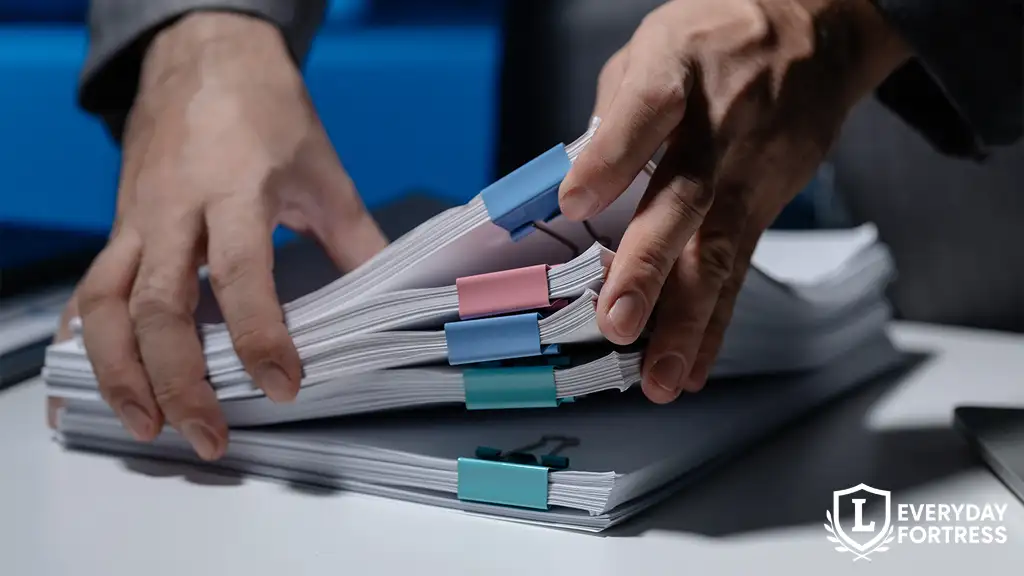Creating your legal life kit is a smart first step. But if your documents aren’t properly stored or accessible when needed, they won’t be much help. That’s why it’s critical to know how to store and share your legal life documents safely — so your loved ones can act quickly and confidently during emergencies.
In this guide, we’ll show you how to protect your legal paperwork from damage, loss, or misuse, and how to share it securely with the right people at the right time.
Why Secure Storage Matters
Your legal life kit contains sensitive, often irreplaceable documents — from your will to your health directives to your power of attorney forms. If these papers are lost, destroyed, or hidden from the people who need them, it can lead to:
- Legal delays or court battles
- Frozen bank accounts and assets
- Emergency medical decisions made without your input
- Confusion and stress for your family or executor
Proper storage means your instructions are protected, accessible, and legally valid — even under pressure.
What to Store (and Why It’s Sensitive)
Before you decide how to store your kit, take a moment to review what’s typically inside:
- Last Will and Testament
- Power of Attorney (financial and medical)
- Advance Healthcare Directive (living will)
- HIPAA release forms
- Copies of ID and passport
- Bank account and insurance info
- Property deeds or titles
- Marriage, divorce, and birth certificates
- Password manager backup or access notes
- List of emergency contacts and executors
All of this information can be misused if it falls into the wrong hands. That’s why how you store and share your legal life documents matters just as much as what’s inside them.
Best Places to Store Legal Documents at Home
1. Fireproof and Waterproof Safe
The gold standard for at-home storage. Choose one with:
- UL rating for fire resistance (30+ minutes minimum)
- Water resistance for flood or burst pipe protection
- Manual override or extra keys (in case you forget the code)
Store originals here: your will, power of attorney, deeds, and IDs.
2. Locked File Cabinet
If you don’t have a safe, a heavy-duty locking file cabinet is the next best option. Use folders to separate documents by category.
Use this for: insurance policies, utility info, duplicate IDs, and copies of sensitive documents.
3. Secondary Copy Location
Store a printed backup at a second physical location — such as your executor’s home or a trusted relative’s safe — in case something happens to your primary location.
How to Store Documents Digitally (Safely)
Going digital adds convenience but also brings risks if done carelessly. Here’s how to handle digital copies safely:
1. Scan and Name Files Clearly
Use a scanner or phone app (like Adobe Scan or Genius Scan) to convert each document to PDF. Rename files with clear titles like:
- “Jane-Doe-Will-2025.pdf”
- “Medical-Power-of-Attorney.pdf”
- “HIPAA-Authorization-June25.pdf”
2. Use Encrypted Cloud Storage
Choose secure, well-known services that offer encryption and two-factor authentication:
- Google Drive
- Dropbox (with password protection enabled)
- iCloud Drive
- Proton Drive (privacy-focused option)
Create a dedicated folder named “Legal Life Kit” and subfolders for each document type.
3. Password-Protect Individual Files
In addition to cloud security, apply passwords to sensitive PDFs using tools like Adobe Acrobat or PDF24.
4. Use a Password Manager
Store access details, safe codes, and cloud logins in a password manager like:
- 1Password
- Bitwarden
- LastPass
- Dashlane
Bonus: some password managers allow emergency access — letting a trusted contact access your vault if you become incapacitated.
How to Share Your Legal Life Kit Securely
Storage is only half the equation. If your documents aren’t shared with the right people, they may go unused at critical moments.
Here’s how to share access safely and effectively:
1. Name Trusted Recipients
You should share your legal kit with:
- Your executor
- Your healthcare proxy
- Your power of attorney
- A backup or secondary trusted person
Never share full access with people you don’t fully trust.
2. Create an Access Plan
Let them know:
- Where your physical kit is stored
- How to unlock your safe (or where to find the backup key)
- What digital platform holds your documents
- What passwords or apps are needed to view them
Use a written “access guide” kept in your safe and emailed to your trusted contact.
3. Use Legacy Sharing Tools
Some platforms allow automatic document handoff:
- Google’s Inactive Account Manager
- Facebook Legacy Contact
- Apple Digital Legacy (via iCloud)
- 1Password Emergency Access
Set these up now — they only take minutes and can eliminate future confusion.
When to Update Your Legal Kit
A legal life kit isn’t one-and-done. You should revisit it at least once a year or whenever major life changes occur:
- Marriage, divorce, or remarriage
- Birth of a child or grandchild
- A move to a new state or country
- Major health changes
- A change in assets, business, or beneficiaries
- Death or replacement of your executor or attorney-in-fact
Mark a calendar reminder every January to review and update your kit.
🧠 You May Wanna Check Out:
Final Thoughts
Creating a legal life kit is only the first step. If it’s not stored safely and shared properly, even the best-drafted documents can be useless in an emergency.
Use a fireproof safe, back up files digitally, and clearly communicate access to the right people. These extra steps don’t take long — but they make your planning effective, actionable, and legally dependable.
For more on protecting personal records, visit the Federal Trade Commission’s guide to document safety.


